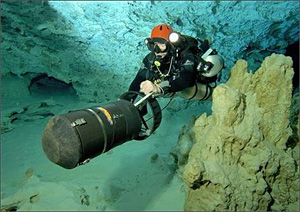 |
 |
 |
 News Around the Republic of Mexico | March 2007 News Around the Republic of Mexico | March 2007  
Divers Say They've Found the World's Longest Underwater Cave in Mexico
 Mark Stevenson - Associated Press Mark Stevenson - Associated Press


| With over 12,000 members and 200 grottos, the National Speleological Society does more than any other organization to study, explore, and conserve cave and karst resources; protect access to caves; encourage responsible management of caves and their unique environments; and promote responsible caving. Visit the website.

|
Mexico City – A pair of cave divers said Monday they have found subterranean passages in Mexico's Yucatan peninsula that constitute the world's longest underwater cave system.


| | The longest previously known submerged cave system is the 91-mile Ox Bel Ha system, located in the same general area. |
British cave diver Steve Bogaerts said he and Robbie Schmittner, of Germany, found flooded underground passages connecting two previously known cave systems – a discovery that shows how interconnected and vulnerable the Yucatan's fabled underground water system is.

Gene Melton, chairman of the Cave Diving Section of the U.S.-based National Speleological Society, a nongovernmental association that tracks cave explorations, confirmed the discovery.

For thousands of years, Mayan Indians depended on water found in the caves and in lakes formed by sinkholes – areas where the caves' ceilings collapsed, opening them to the surface. The lakes dot the Yucatan peninsula, now one of the world's fastest-growing sites for tourism and resort developments.

Bogaerts said his dives proved a connection between the Nohoch Nah Chich caves and the Sac Actun system, which together measure 95 miles in length. That connection shows that many of the seemingly isolated watering holes are part of a single larger system, he said.

The longest previously known submerged cave system is the 91-mile Ox Bel Ha system, located in the same general area, according to documents posted by the Speleological Society on its Web site.

“That's the important thing for people to understand. ... The point is that they're so interconnected,” Bogaerts said. “There are so many cave systems that if there's a point of pollution in any one particular area it can spread very extensively throughout the entire system.”

Bogaerts and Schmittner spent four years swimming the length of the system, making about 500 dives with scuba tanks, linking one sinkhole lake to the next. Some passages were “big enough for a jumbo jet,” while others were so narrow divers had to remove their tanks to wiggle through.

The breakthrough discovery – the passage connecting Nohoch Nah Chich (“The Giant Birdcage” in Maya) and Sac Actun (“White Cave”) – was made by the two divers on Jan. 23.

Jonathan Martin, an assistant professor of geology at the University of Florida, said the discovery – which has not yet been published in scientific journals – appeared feasible, based on the geological formations of the Yucatan.

On the Net: National Speleological Society: www.caves.org/ | 
 | |
 |



